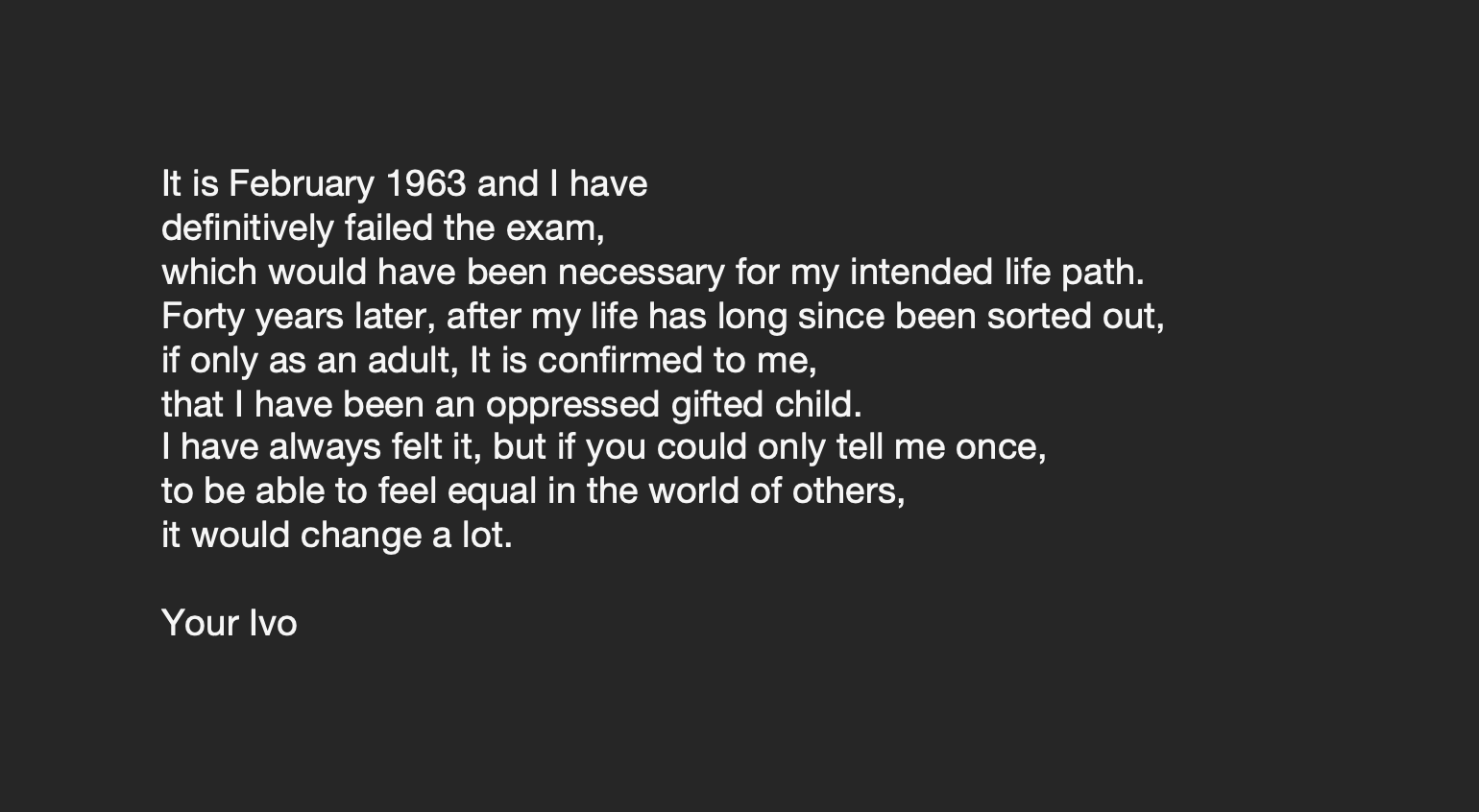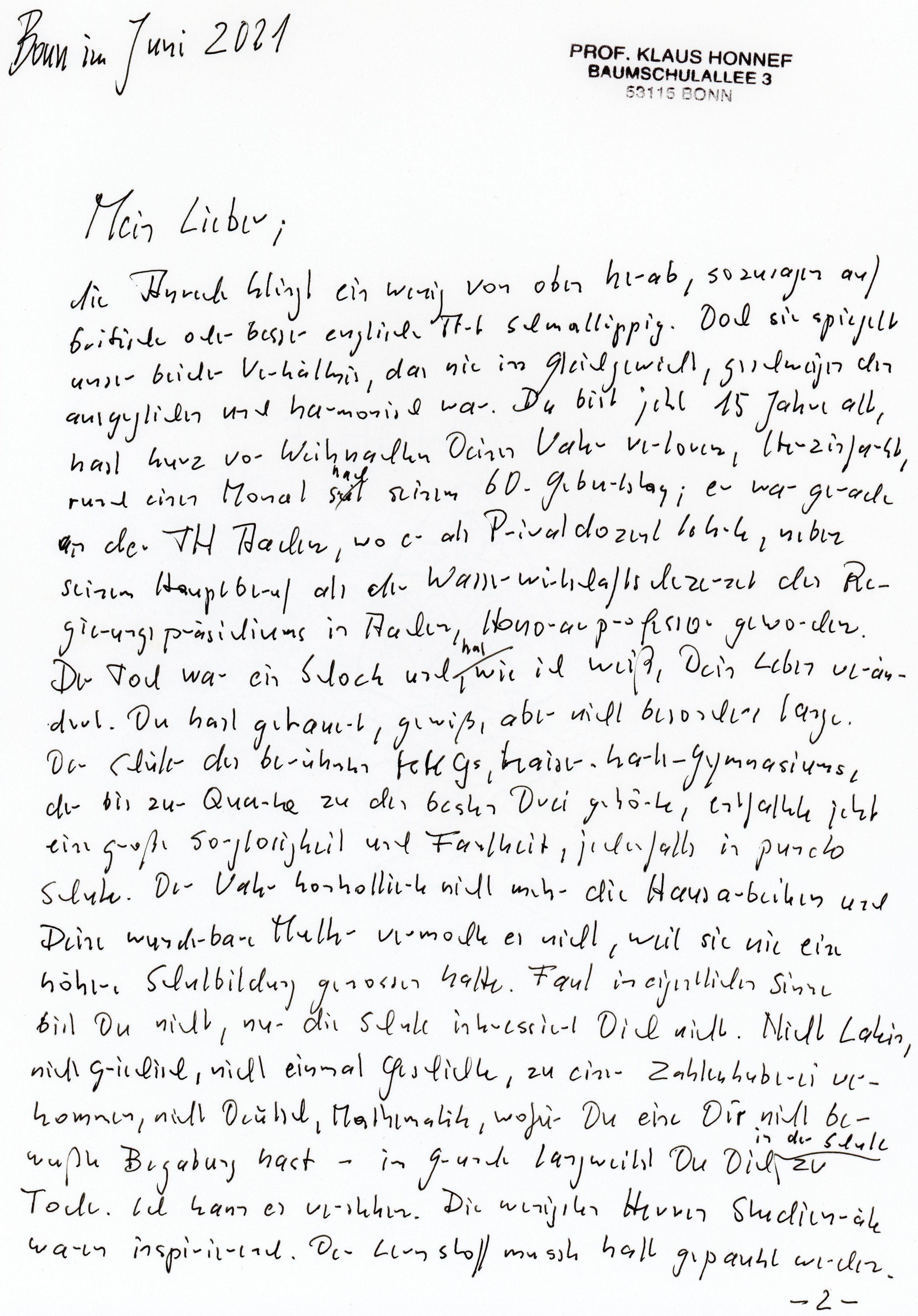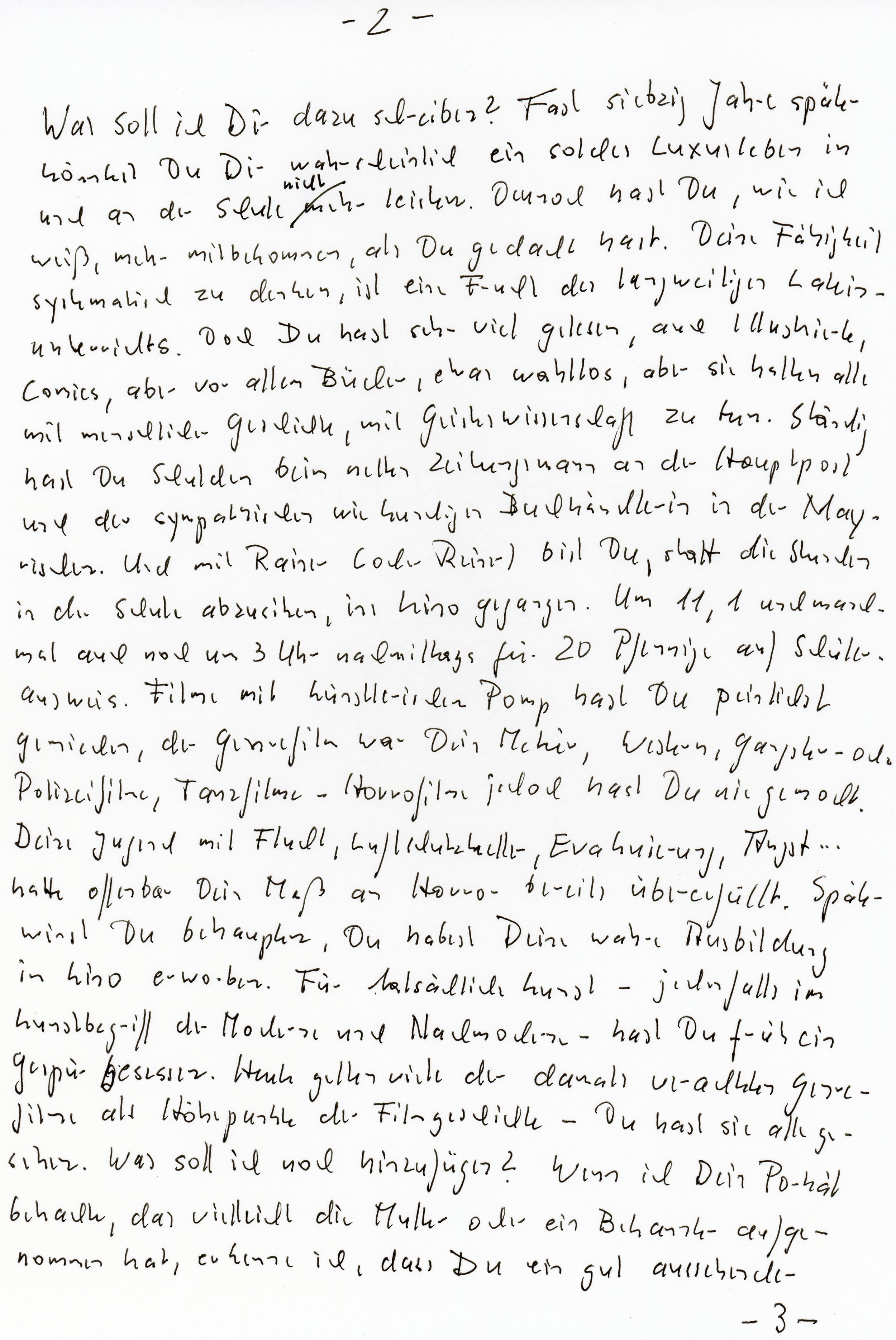My inner child and me -
a document from individual
TIME TRAVELERS
Nick Ut and Kim Phuc („The Vietnam Napalm Girl“)
This project is about the discussion of life plans, one's own life - and the way in which the depiced persons deal with and communicate them. The three part-project consists of a children’ s photo, a handwritten letter to the child, and a current photo. They tell individual life stories.
That creates a stage for every protagonist.
The letter
The "time traveler" imagines what he would tell or wish the child (who he used to be)
if he had the chance to meet him today - in his past.
What would he want to share with him?
He writes this letter to his former child and decides individually what he wants to reveal or where he puts his focus.
Why should the letter be handwritten, if possible?
Each handwriting is individual and allows to get a further impression of a person/his energy.
The children`s photo
...gives an insight, a small idea of what the time traveler looked
and acted like in his childhood -
and to whom this letter is addressed.
Participants
• Nick Ut, AP Photographer (who had photographed the „Vietnam Napalm Girl" in Vietnam, named Phan Thi Kim Phuc)
• Phan Thi Kim Phuc, UN Peace Ambassador, Canada
• Henry Dallal, Photographer, Iran
• Klaus Honnef, art historian, art critic, exhibition curator and theoretician for artistic photography, Cologne
• Michael Horbach, Collector and founder of the Horbach Foundation, Cologne
• Kristian Schuller, Fashion photographer, Berlin
• Wolfgang Zurborn, Photographer with teaching assignments at colleges/universities, Cologne
• Ivo von Renner, Photographer, Hamburg
• Andrea Lüdke, Actress, Hamburg
• Rolf Scheider, Casting Director and Entertainer, Paris
• Max Jeschek, Musician, Wiesloch
• Esther Schuler, Actress, sign language interpreter, Essen
• Geraldine Rosteius, Dancer, Cologne
• Frank Dürrach, Co-founder and lecturer Fotoschule (school for photography), Cologne
• Michael Köckritz, Publisher, Reutlingen
• Nadine Dinter, Agency for press relations, PR consulting and art administration, Berlin
• Birgit Gerlicher, Autism Educator, Karlsruhe
• Peter Franck, Photographer, Stuttgart
• Damian Zimmermann, Photographer, Cologne
• Petra Gerwers, Photographer, Online editor Magazine ProfiFoto, Mönchengladbach
• Rainer Claaßen, Photographer, Hamburg
• Saskia Brieger, Stewardess, Erkelenz
• Thomas Gerwers, Publisher Magazine ProfiFoto, Mönchengladbach
• Thomas Rössler, Photographer and Lecturer, Saarbrücken
• Natascha Langen, Nature conservation NABU, Heinsberg
Foreword
by Klaus Honnef
Anyone who, like me, is not inclined to have a particularly intimate relationship with oneself must find a project like “Time Travelers” by Petra Gerwers unusual and somehow fascinating. In fact, it invites us to take a journey into our own past – not just a journey of thought – but by addressing a letter to our own person. However, not in now-time, which is already past, when I mentioned it a moment ago. The pivotal point in this context is rather a portrait for which the time traveler has once posed in front of the camera or has been captured by a camera in a certain position. Since I have only a few pictures from my school and student days and never look at them, it was not easy for me to find a corresponding picture. So, I addressed my letter to the person in this picture, in my case a boy of about 15 years.
In short, I was suddenly confronted with a situation that I have avoided until now, for reasons I did not know. But on the other hand, Petra Gerwers already had me on the fishing hook, and I was, without intending to, already mentally on a journey to myself. However, I did not feel that I had much connection with the addressee of my letter. Although no one else than I was; more precisely – according to Roland Barthes – has been. Nor did the non-relationship change after the letter was completed. This may be different with other time travelers. Nor can I say that I dislike the boy in the early portrait, not at all, he rather seems foreign like the time back then. He even looked better than I thought. Nor can I say that the portrait reminded me of an unfortunate past, on the contrary. Nor, however, to a memorable one, although the years at the humanistic Gymnasium in Aachen, the renowned Kaiser Karl Gymnasium, went very turbulent.
But I’ve never been interested in subjective memories. My view was always straight ahead instead of backwards, as it has long since become a cliché. However, I am happy to admit that Petra Gerwer’s “Time Travelers” is one of the few artistic projects that has touched me so much that I decided, without thinking too much, to get involved in her initiative. I can’t give a reasonable reason for that. But this shows me that the photographer has hit a certain point, and I can imagine that the passengers who, like me, set out on the journey into their own selves felt the same way. In this I see the specific quality of the project, and I therefore wish “Time Traveler” the viewers and readers in particular, who have preserved a weakness for the extraordinary.
Epilogue
by Wolfgang Zurborn
Photographic portraits can be created from very different motivations. On the one hand, there is a belief in being able to create an authentic, true image of the human being, while on the other hand, doubts about it lead to photographic stagings, concepts and experiments that emphasize rather fragile constructions of identities in portrait photography. Whereas August Sander, with his hyper-precise objective photographs of people, formulated the claim to be able to represent the entire psychology of the depicted in one photograph, Richard Avedon says of his portraits, also photographed with extreme precision: “It’s all fiction, never make the mistake to think it’s reality.”
Where on the scale between authenticity and fiction are Petra Gerwers' images of humanity in the photo project “Time Travelers”?
She does not trust to be able to create a clear picture of her protagonists just with a photograph of the present. Only the combination of the created portraits with children’s pictures of the depicted and the letters they write to themselves as the former child they once were breaks down the frozen images of the people. The longings and fears expressed in the lines, rational and emotional advice for the future are reflected in the faces of those portrayed as children and adults. However, it is not possible to read clear messages, rather hints of life plans.
The photographer’s core interest is communication with her fellow human beings, and this requires an artistic concept that shows them in a complex network of relationships that is subject to constant change in a living process. Her portraits with multi-layered reflections liberate people from a static representation of their personality and allow a glimpse behind the facade. In her project there is no system of order in which people are integrated. They are not sorted by professional, political, social, or cultural groupings. Petra Gerwers chooses her protagonists purely subjectively and it is all about the personal “time travel” of people who have aroused her interest.
I am very happy to be part of this selection, even if I myself found it a great challenge. One’s own biography can be defined in very different ways. When I was asked to write a letter to myself as a 10-year-old boy and looked at family pictures from the mid-60s in a dusty album, the retrospective view of my own life as a straightforward design began to crumble. But I did not see this as a deficiency, but as the actual formulation of a consciousness for itself. The special quality of Petra Gerwers' work “Time Travelers” lies in the sensitization for this process of self-discovery.
Phan Thi Kim Phuc, “the girl in the photo”*, and photographer and Pulitzer-Prize winner Nick Ut
*"The Terror of War", June 08, 1972
“I remember very well the first time I saw the photo. It was when I got home from the hospital. I was very ashamed. Why was I naked and my brothers and cousins were wearing clothes? My face was so ugly, so desperate, I cried… When I was a kid, I found the picture so ugly. I didn`t like it at all.
That changed as I got older. And ten years later, I realized what a huge impact this image had on people. I wasn`t ashamed anymore, but it did not mean too much to me until I became a mother myself. With my son on my arm, I looked at the picture and thought: No child in the world should be subjected do such suffering as this little girl. From that moment on, the picture gave me strength. When the photo was taken, I had no choice. Now I am free, I have a choice, and this picture has made me work for peace.
I was one of millions of children who become victims of war. And I am so thankful that I have been given a future! And I thank God I am still alive. And I do not live in sorrow, bitterness or hatred, but with the love of the people around me. They inspire me, and now I have the opportunity to give something back. I can tell these children: I was there as you are now, and I want to help you when you talk about pain, I understand you. When you talk about hatred and violence, I understand you. What you need is peace and joy. And I am not doing this out of duty, but because I really care about them.”
Kim Phuc
















